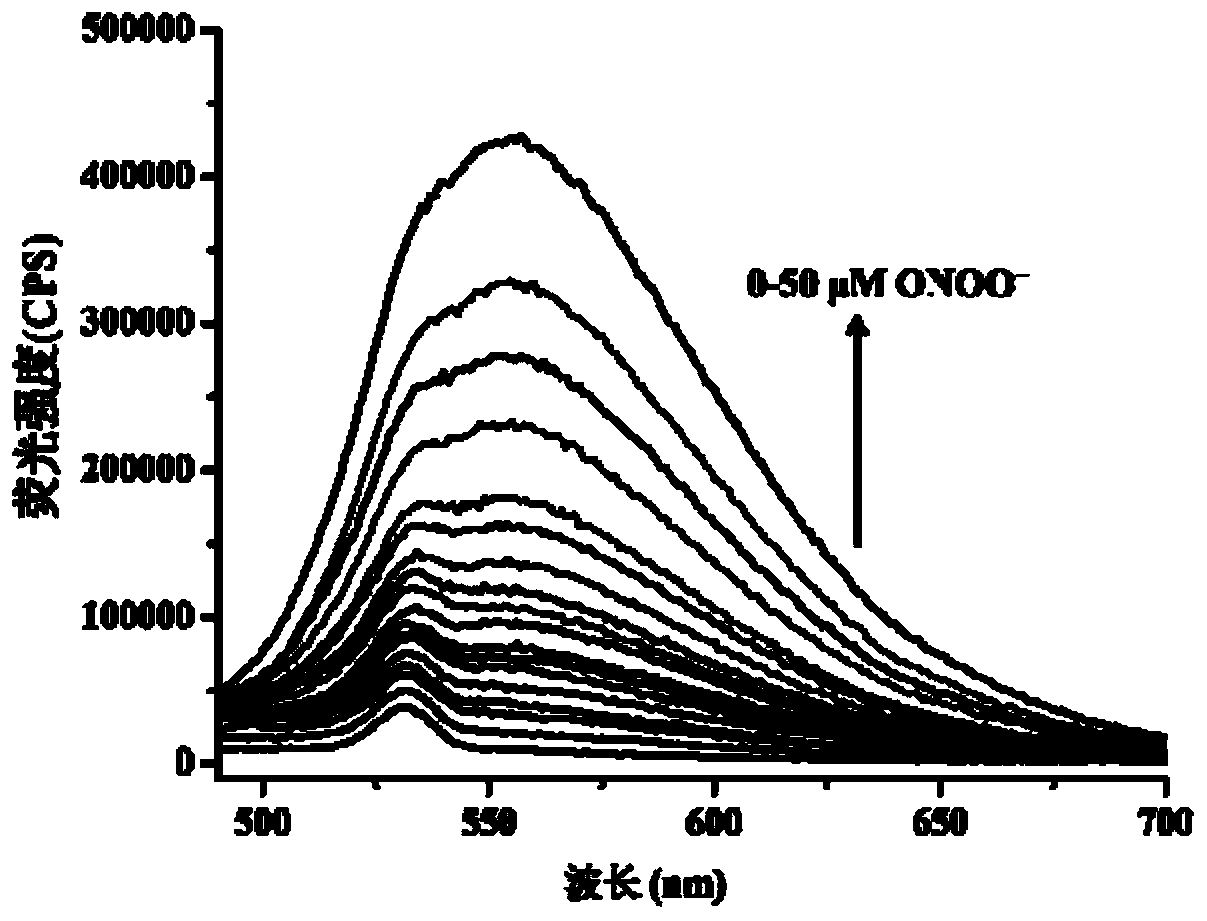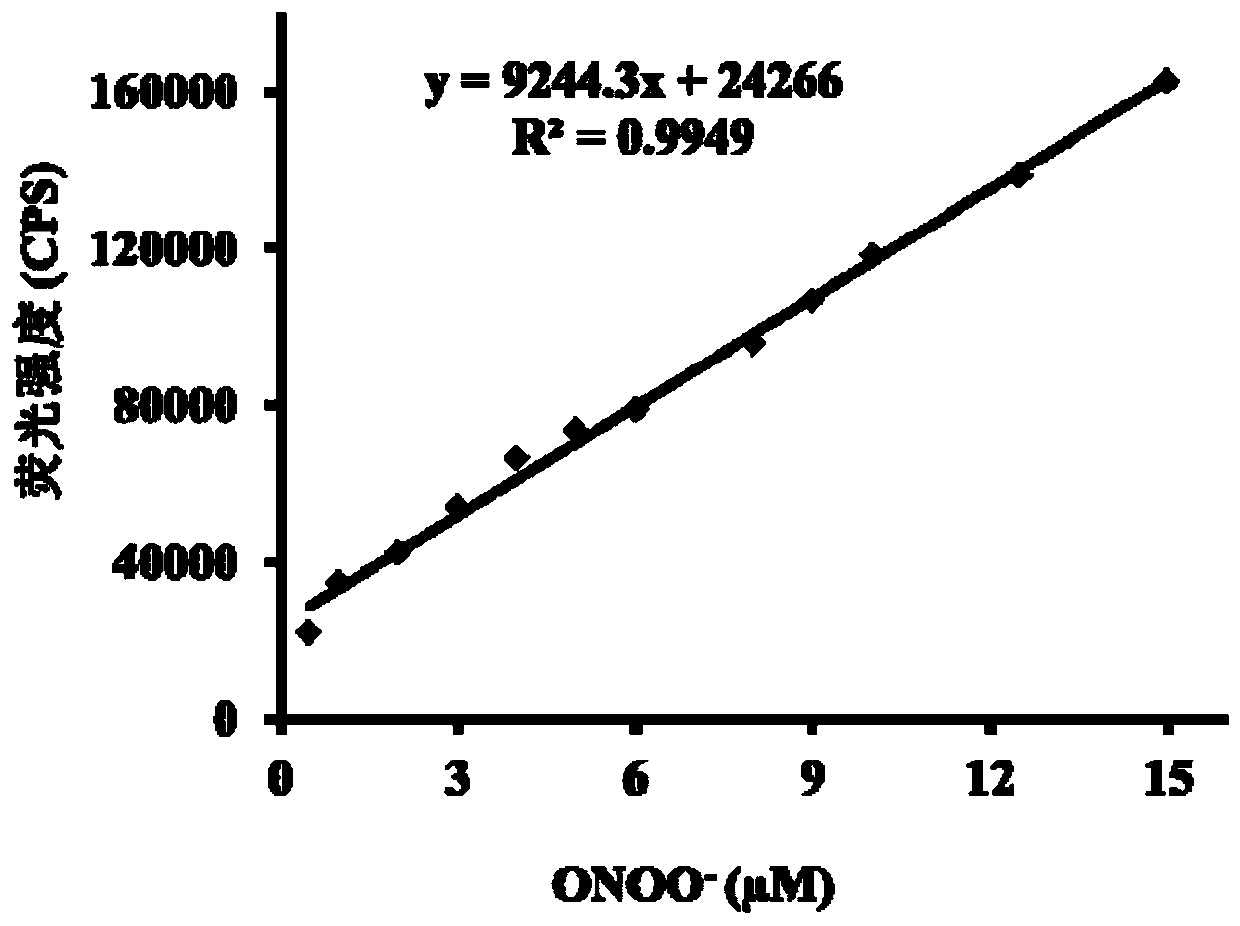High-selectivity and ultra-sensitive liver cancer specific peroxynitrite probe and application thereof
The technology of a compound and naphthalimide is applied in the field of highly selective and ultrasensitive liver cancer-specific peroxynitrite probe and its application field, which can solve the problems of inability to specifically detect liver cell peroxynitrite and achieve a reaction Sensitive, simple synthesis, good stability
- Summary
- Abstract
- Description
- Claims
- Application Information
AI Technical Summary
Problems solved by technology
Method used
Image
Examples
Embodiment 1
[0034]
[0035] (Scheme 1) Dissolve 500mg (1.46mmol) of naphthalimide compounds in 10mL of water and dichloromethane (1:1), then add 450mg (1.21mmol) of galactose compounds to reflux for 12h, extract under reduced pressure The solvent was evaporated to dryness. Dissolve the product and triethylamine (5ml) in a mixed system of 9ml methanol and water (8:1), stir at room temperature for 12h, spin the solvent under reduced pressure, if you want to get a purer product, you can use the crude product The mixed system of dichloromethane and methanol (for example, v / v, 10:1) was separated by column chromatography to obtain the pure product, and 430 mg of the pure yellow product was obtained with a yield of 54%.
[0036] (Scheme 2) Dissolve 500mg (1.46mmol) of naphthalimide compounds in 10mL of water and dichloromethane (1:1), then add 708mg (1.9mmol) of galactose compounds to reflux for 12h, extract under reduced pressure The solvent was evaporated to dryness. Dissolve the product...
Embodiment 2
[0041] Figure 1a is the fluorescence spectrum of the probe (5 μM) before and after adding peroxynitrite (0-50 μM). Figure 1b It is a linear relationship diagram of different concentrations of peroxynitrite (0-15 μM) to probe (5 μM).
[0042] Configure multiple parallel samples with a probe concentration of 5 μM in a 10mL colorimetric tube, then add different concentrations of peroxynitrite into the test system, shake it evenly and let it stand. The above determinations were carried out in a pure water (20mM PBS, pH 7.4) system, the probe used was the probe prepared in Example 1, and all spectral tests were measured at 25°C.
[0043] Fluorescence intensity changes were measured with a fluorescence spectrometer, from Figure 1a It can be clearly seen that as the concentration of peroxynitrite increases, the fluorescence intensity at 550 nm increases gradually. and, by Figure 1b It can be seen that after the fluorescent probe (5μM) is added to peroxynitrite (0-15μM), there i...
Embodiment 3
[0045] figure 2 is the response time of the probe (5 μM) after addition of peroxynitrite (10 μM). Take 50 μL of the probe mother solution and place it in 10 mL of the test system, then add 10 μM peroxynitrite into the test system, shake it evenly, and immediately measure the change of its fluorescence intensity with a fluorescence spectrometer. The above determinations were carried out in a pure water (20mM PBS, pH 7.4) system, the probe used was the probe prepared in Example 1, and all spectral tests were measured at 25°C.
[0046] It can be clearly seen from the figure that after the addition of peroxynitrite, the fluorescence intensity reaches the maximum value and remains unchanged after detection for about 3s, which indicates that the probe reacts rapidly with peroxynitrite and can be used for peroxynitrite. The determination of nitrate provides a rapid analytical method.
PUM
 Login to View More
Login to View More Abstract
Description
Claims
Application Information
 Login to View More
Login to View More - R&D
- Intellectual Property
- Life Sciences
- Materials
- Tech Scout
- Unparalleled Data Quality
- Higher Quality Content
- 60% Fewer Hallucinations
Browse by: Latest US Patents, China's latest patents, Technical Efficacy Thesaurus, Application Domain, Technology Topic, Popular Technical Reports.
© 2025 PatSnap. All rights reserved.Legal|Privacy policy|Modern Slavery Act Transparency Statement|Sitemap|About US| Contact US: help@patsnap.com



